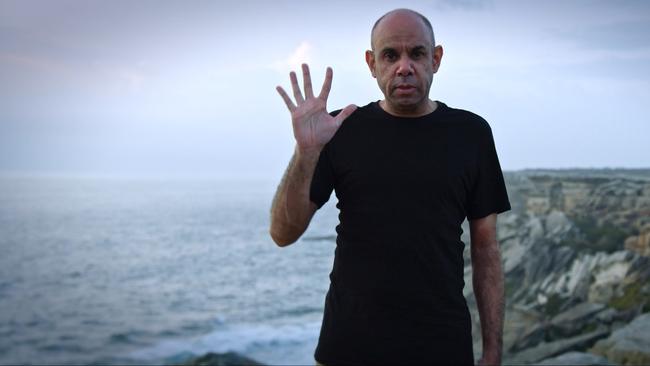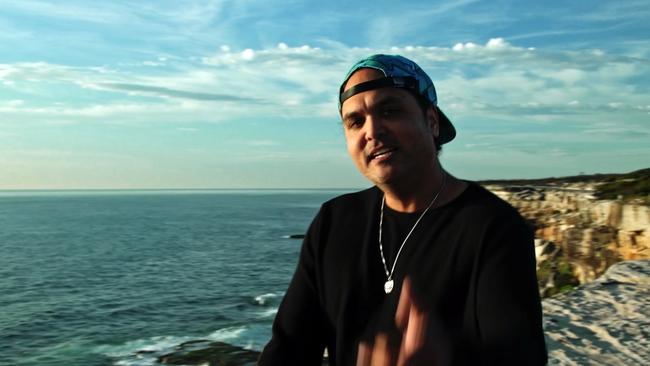Film puts statues, Captain Cook in spotlight against #BLM backdrop
In his new film Looky Looky Here Comes Cooky, Steven Oliver has crafted a modern-day songline around the narrative of Captain Cook.

Statues have been erected to James Cook, Scott Morrison’s electorate is named for him: so are pubs, parks, bridges, roads, a town, a mountain, a cottage, a university and a sandwich. In Looky Looky Here Comes Cooky, poet, performer and Black Comedy star Steven Oliver reflects on this ubiquity as he heads off to the Captain Cook Hotel in Sydney to sample a Captain Cook steak and ciabatta, and to ask himself, “Who is this figure, and what role does he play in Australia’s vision of itself? Is there another way of talking about him?”
Looky Looky Here Comes Cooky answers those questions in a very specific fashion. It’s the story of Cook, on the 250th anniversary of his voyage to Australia, seen through the eyes of First Nations people and in songs specially written by some of Australia’s leading Indigenous singers and musicians. Oliver, a subversive, exuberant presence, crisscrosses the country to talk to participants, historians and traditional owners as well as musicians. The tone can be lighthearted one moment, full of pain the next. There are performances of the songs, and some of Oliver’s sharp, passionate poems.
There are many stories, inevitably, yet there is one recurring Cook narrative deeply embedded in the consciousness of virtually all the participants in the film. They heard it in school, when they were all told that Cook discovered Australia. It’s a story with a legacy, a story of erasure and denial. And it’s not over, as many of the voices in the film emphasise: the past is still unfinished business, unacknowledged and unresolved.
“It’s funny, people say you live in the past,” Oliver says. “And I’m like, well, hold up, you’re the one celebrating the 250-year anniversary. And it’s good to have these discussions to make people go, ‘Oh yeah. I’ve never really thought about it like that.’ ”
Looky Looky gives an account of Cook’s voyage from England, and Endeavour’s journey up the east coast of Australia, told in animated sequences that also depict his first encounters with Indigenous Australians. But there are some contested elements: Did he really land on Possession Island, as the story goes, and plant a flag? Or did he remain offshore? And there are other voices and points of view.
Many of the songs — from performers such as Trials, Kev Carmody, Alice Skye, Birdz, Fred Leone, Mau Power and Mo’Ju — propose other figures, anonymous but significant.

Birdz has a song from the perspective of a young warrior, standing on the shore, watching the Endeavour sail into sight. Mo’Ju imagines the figure of a medicine woman, someone who foresaw all the dangers that were to come, cautioning her people to be wary.
The legacy of Cook is discussed in a range of ways. Some acknowledge his achievements as a navigator and cartographer. “I do have a respect for Cook,” says historian and Guugu Yimithirr traditional owner Alberta Hornsby. “But I have far greater respect for my ancestors.” For Mo’Ju, Cook functions as “the poster boy for colonisation … When you’re building a monument to Captain Cook, you’re not just building a monument to a person, it’s like a monument to the institution and the system that he represented.”
Looky Looky Here Comes Cooky, Oliver says, draws on Indigenous singers and songwriters to create “a modern-day songline. One that embraces themes of first contact, resistance, language and the truth.” But these perspectives, he says, are part of a whole story, not a minor add-on. Quoting academic Margo Neale he says, “Songlines shouldn’t be an anthropological footnote but a real part of our history, taught in schools. To tell the real story of this continent, you’ve got to have both histories. They are held in different ways, told in different ways, but are essentially complementary.”
Being part of the filmmaking process has changed some of his views about Cook. “We live in a society where we’re often told to think something and we never actually sit down and question. People are told to think Cook’s a hero or to think he’s a villain. And the funny thing is, he’s both these things at the same time to different people.”

Oliver is a co-writer of the film, alongside Danielle MacLean and director Steven McGregor (co-writer of Warwick Thornton’s Sweet Country). When he was approached to take part, he says, “I was a bit tentative at first. I’ve done sketch comedy, written stuff for the screen, web series, plays and poetry, but never actually a doco before.
“But I thought, just get out of your comfort zone and take the bull by the horns. And I think it’s such a rewarding experience,” particularly working with a creative team that includes so many Indigenous people. “Aboriginal people often talk about our ancestors and those who have stood before us, and standing on their shoulders. But we lean on shoulders as well.”
Many things have changed since the Looky Looky team started work on the project. Their film is being premiered in a context they could never have anticipated. Last year the Prime Minister went to Cooktown to announce a host of Captain Cook commemorative events for this year, including a circumnavigation of Australia by a replica of the Endeavour. But many of them have been cancelled or postponed because of COVID-19.
And this year the Black Lives Matter movement highlighted many issues, including the place statues to some significant historical figures. This has led to protests and reappraisals in Britain and the US as statues of figures involved in the slave trade and monuments to the Confederacy began to be taken down.
Monuments to Cook have been subjected to some of the same scrutiny. For Oliver, the important thing is to reflect on the implications of this. Looking at a recent photograph of police officers standing guard over the statue of Cook in Sydney’s Hyde Park, on Gadigal country, he says, he immediately thought of a very different example. When he was living in Perth, he remembers, there was a statue to a Noongar warrior, Yagan, that was constantly being desecrated. Yagan, who led a movement of resistance, was shot and killed in 1833. His head was cut off to claim the bounty that had been put on it and was later sent to a museum in England.
In a particularly macabre way, “People were always vandalising the statue by cutting its head off,” says Oliver. “Eventually they had to move it out onto an island.
“So a statue of Cook, or a statue representing colonialism, is so precious. Yet a statue representing Aboriginal resistance can get decapitated over and over again, without an outcry or an uproar? Why is it so wrong to spray-paint a Cook statue but OK to do what was done to the statue of an Aboriginal warrior, over and over again, so that you have to move it to an island where people can’t touch it?”
Encouraging people to think independently is what is important to Oliver. “When I do work,” he says, “it’s not so much about telling people what Aboriginal people think — it’s how Aboriginal people think.” With that in mind, he wants people to reflect for themselves, take stock, ask themselves questions, go beyond received ideas. “To think for themselves, at the end of the day. And, maybe, think about us sometimes.”
Looky Looky Here Comes Cooky is screening at Melbourne International Film Festival on August 16 and on SBS Viceland and NITV on August 20.

To join the conversation, please log in. Don't have an account? Register
Join the conversation, you are commenting as Logout